 Prussian Navy – Ironclad 1866-1921
Prussian Navy – Ironclad 1866-1921
SMS Kronprinz was a single German broadside ironclad built for the Prussian Navy in 1866–1867 at Samuda Brothers shipyard, Cubitt, London. Launched in May 1867, she commissioned in September and took her place as the fourth ironclad ordered by the Prussian Navy, entering service before the French built Friedrich Carl. She was designed as an armored frigate with an iron hull, barque rig, armed sixteen 21 cm (8.3 in) guns and modified several times during her career. In the Franco-Prussian War of 1870–1871, Engine troubles prevented all but two short sorties against the French blockade in which she saw no combat. She had limited modernizations and in 1901 converted into a training ship for boiler room personnel, sold for BU 1921.
Development
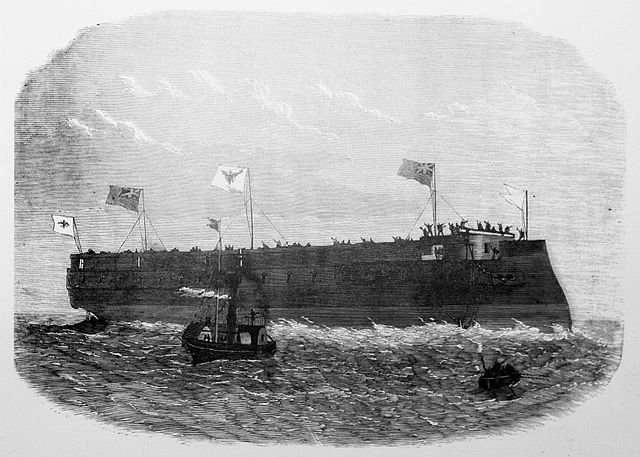
After the acquisition of the small coastall ironclad rams SMS Arminius and Prinz Adalbert the general staff of the Prussian Navy wanted to acquired true seaworthy ironclads for prolongated operations in the Baltic and beyond. At the time the main theat was Denmark and its navy, still superior to the Prussian’s. The Second Schleswig War saw indeed a blockade of German ports which had no answer at that time and was remembered as an humiliation, even if the Danes only mobilized Frigates and ships of the line. Armored frigate from 1860 seemed a perfect answer as few were necessary to really scare the Danes out. Approval from the Landtag in 1865 was initially refused, so King Wilhelm I went over it by decree on 4 July and authorized the purchase abroad of two armored frigates, which became Friedrich Karl and Kronprinz.
Britain and France were the leader in that field, with experienced shipbuilders so as a test and to sample tech from both until Prussian Yards were able to start their own constructions, one vessel from each country was ordered. Contract for Kronprinz was placed on 13 January 1866 in Britain, four days after Friedrich Carl in France. The British-built Kronprinz was followed the design adopted for HMS Defence and Hector proposed by naval architect Edward Reed (Chief Constructor of the Royal Navy from 1863 until 1870). They ended similar in some ways to Friedrich Carl. To give better context, after the very expensive but prestigious first Warrior class, Britain reoriented its programme towards smaller, cheaper and more practical vessels. Despite being smaller and less well armed with the Warriors, they still were perfectly suitable to answer French ironclads, based on wooden hulls. Reed had a special place among DNCs as he also created HMS Bellerophon and its “bracket frame” construction in 1865, the ocean-going turret-ship HMS Monarch in 1868 and the mastless turret ship HMS Devastation in 1871.
Design of the class
Hull and general design
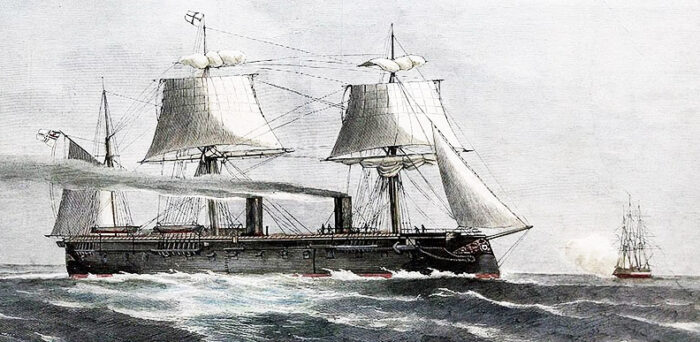
Kronprinz measured 88.20 meters (289 ft 4 in) long (waterline) or 89.44 m (293 ft 5 in) long overall with her ram. Her beam was 15.20 m (49 ft 10 in) and draft of 7.85 m (25 ft 9 in) forward, down to 7.45 m (24 ft 5 in) aft. She displaced 5,767 metric tons (5,676 long tons) at normal load but up to 6,760 t (6,650 long tons) when fully loaded. Construction was all metal with teak backing. Sje had iron transverse and longitudinal frames. The hull was dubdivided between nine watertight compartments below the waterline, including a double bottom over 43 percent of the hull’s bottom. When trialled she proved to be an excellent sea boat, very responsive at the helm but with a large turning radius. There was a single rudder with backup casptan connection for manual backup. Her crew was labor intensive with 33 officers and 508 ratings, knowing she needed a sail crew, a machinery crew, plus ten men per artillery post. To evacuated these she had a fleet of smaller boats, with four under davits and the rest in the large hold aft of the mainmast, with a large tender for cialing in any port, two launches, a pinnace, two cutters, two yawls, and one dinghy.
Powerplant
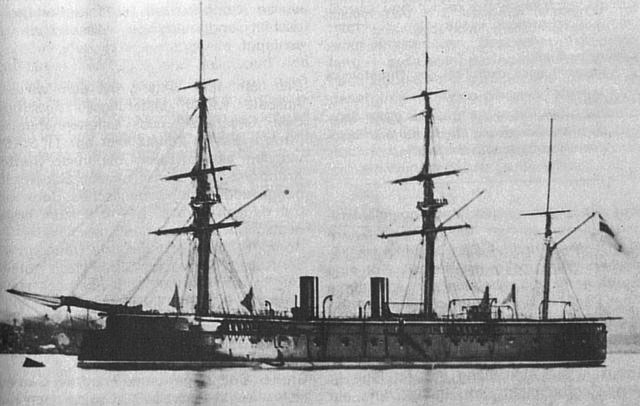
Her propulsion system wame from John Penn and Sons of Greenwich. This powerplant comprised an horizontal, two-cylinder single-expansion steam engine. It was driving a two-bladed screw which was 6.5 m or 21 feet 4 inches in diameter. The steam engine was fed by Eight trunk boilers. Each had four fireboxes. They were fitted in two boiler rooms separated by waterproof and fireproof bulkheads. Each room was vented into a single funnel which (so two in all), typically of the time, was collapsible while under sail to free their moves and avoid bruning the sails altogether. These boilers made of forged furnaces worked at 2 standard atmospheres (200 kPa). The whole powerplant was rated for 4,500 metric horsepower (4,400 ihp). As contracted it was able to give these ships a top speed of 13.5 knots (25 km/h; 15.5 mph), and on trials Kronprinz reached 4,870 PS (4,800 ihp) for 14.7 knots (27.2 km/h; 16.9 mph). For range, she carried 646 t (636 long tons) of coal in the max load configuration, enabling 3,200 nautical miles (5,900 km; 3,700 mi) maximum at the cruising speed of 10 knots (19 km/h; 12 mph). At 14 knots, full steam ahead, the range was down to 1,730 nmi (3,200 km; 1,990 mi).
Of course she also had a complementary three-masted barque rig. Its surface area was 1,980 square meters and with it, range was unlimited but speed was limited to perhaps 8-10 knots. By raising up the foresail and mainsail it was still possible in theory to have the funnels deployed and combine it to full sails for some manoeuvers. It is unknown how much the combination was effective.
Protection
Kronprinz’s protection rested on a set of wrought iron plating, backed with heavy teak planking, typial of British (and French) construction at the time.
-The waterline armored belt went from 76 mm (3 in) at the stern to 124 mm (4.9 in) amidships, then 114 mm (4.5 in) toward the bow.
-The belt was backed with 254 mm (10 in) of teak.
-Above it was the battery strake of iron plate from 114 to 121 mm (4.5 to 4.8 in) in thickness.
-This strake over the broadside battery was backed by 254 mm of timber
-The battery’s roof had a 9-millimeter-thick (0.35 in) iron plating mostly deflect shots that could pass the side bulwarks and splash over it or shrapnel.
-There was no conning tower nor armour deck.
Armament
Original Battery:
SMS Kronprinz was designed originally with a a main battery of thirty-two rifled 72-pounder cannon, or RBL 6 inches. They had the typical Armstrong screw, with vertical sliding vent-piece block for a muzzle velocity of 1,100 feet per second (340 m/s) and max range of 3,500 yards (3,200 m). However if they were purchased and installed and if the ship departed Britain with them, they will not stay for long.
2x 21cm/L22
After delivery to Germany, they were replaced with sixteen 21 cm Krupp guns. They were called RKL/22.5 C/68 and were RMLs, rifled muzzle loaders.
The longer 21 cm (8.3 in) L/22 guns were completed by fourteen shorter 21 cm RK L/19 guns. The L/22 gun could depress down to −5 degrees or elevate up to 13 degrees, better than the british ordnance, procuring a range of 5,900 m (6,500 yd). The L/22 guns were placed on the upper deck, centerline with railings in order to give them sufficient traverse and placed on either end of the ship, as chase guns.
14x 21cm/19
The short barreled L/19 (209mm/17 RKL/19 C/67) guns had a wider elevation from −8 to 14.5 degrees, but lower muzzle velocity, with a range down to 5,200 m (5,700 yd). These fourteen L/19 guns were in the central battery amidships, seven per broadside. Outer ports were fake ones. The two Krupp 209 mm guns fired the same shell, and on board there was a full supply of 1,656 rounds.

Kronprinz in the 1880s
Upgrades
In 1881 they had their first upgrade, keeping their main guns but seeing the addition of six 5-barreled 37mm/27 RV L/30 Hotchkiss QF guns and five 350mm or 13.8 inches Torpedo tunes: Two at the bow, two in the beam, and one in the stern. They were all above water, and supplied with 12 Schwartzkopf torpedoes. The six 3.7 cm (1.5 in) Hotchkiss revolver cannon had individual mounts and were all placed on the upper deck as a close defence against torpedo boats. This was not altered much as the ship became a TS.
⚙ specifications |
|
| Displacement | 5,767 t (5,676 long tons) normak, 6,760 t (6,650 long tons) FL |
| Dimensions | 89.44 x 15.20 x 7.85 (293 ft 5 in x 49 ft 10 in x 25 ft 9 in) |
| Propulsion | 1 propeller, 1 single-expansion steam engine, 8× boilers 4,500 PS (4,400 ihp) +sails |
| Speed | 13.5 knots (25.0 km/h; 15.5 mph) |
| Range | 3,200 nmi (5,900 km; 3,700 mi) at 10 knots (19 km/h; 12 mph) |
| Armament | 2× 21 cm (8.3 in) L/22, 14× 21 cm (8.3 in) L/19 |
| Protection | 76 to 124 mm (3.0 to 4.9 in) |
| Crew | 33 officers +508 enlisted |
Career of SMS Kronprinz
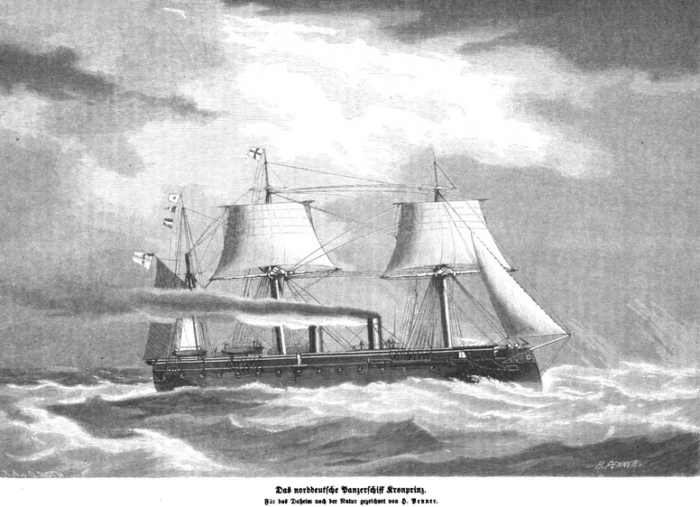
SMS Konprinz (Crown Prince) was ordered on 13 January 1866 and she was laid down by late February to Samuda Brothers shipyard in London, baptised by King Wilhelm on 10 January 1867. In 6 May the launching ceremony saw a Prussian delegation with the ambassador, Albrecht von Bernstorff, Kapitän zur See (KzS—Captain at Sea) Ludwig von Henk. Sea trials started on 6 August with representatives from the Prussian Naval Ministry notably captain Henk, later her first commander on 19 September, when transferred and commissioned. Crews for both ironclads, the second in France, were carried by the screw frigate SMS Hertha and corvette Medusa. When they arrived in Portsmouth, Britain, the ironclad just completed another set of trials.
SMS Kronprinz departed Britain on 24 October for the Baltic but encountered a seever storm and lost her main mast. She was eetn in drydock on arrival in Kiel on 28 October, mast repaired and armament converted.
She had a new serie of trials on 1 November supervised by Prince Adalbert until decommissioned on 16 November. The new Prussian guns presented issues, originally intended but using Kreiner breech blocks that proved to fail in 1867–1868 tests. New Krupp-designed guns were substituted hampered by shortage of carriages so she was ony recommissionned by 11 May 1869. She returned to Britain in dry-docked for her hull cleaned and having marine biofouling. Back in the baltic she joined the Training Squadron for exercises held from 30 August to 10 September at the Kieler Förde with sisters Friedrich Carl and König Wilhelm. She was decommissioned at Kiel-Ellerbek on 25 September 1869, recommissioned on 30 April 1870 for training routine in Squadron and for the next years, in the summer months, reserve in winter and a single ship chosen alternatively as premament guard ship in reduced commission.
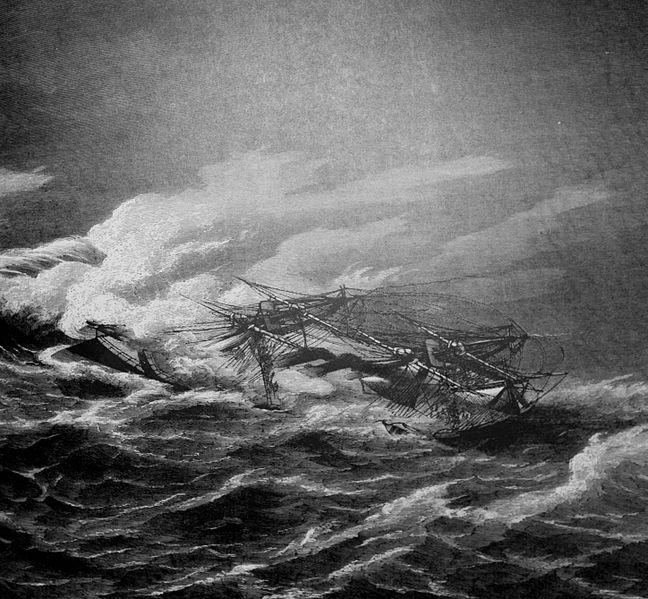
In May 1870, she visited Britain, with the gunboat Cyclop, whioch towed the damaged Friedrich Carl back to Kiel and back to Britain to change her screws on 2 June. All were in Plymouth by 1 July and started a training cruise to Fayal, Azores. Tensions with France (Hohenzollern candidacy) had them ordered back asap as they were crossing the English Channel. Prinz Adalbert was sent to Dartmouth to stay informed of events and the rest of the squadron arrived here on 13 July and then headed for Wilhelmshaven. Kronprinz towed Prinz Adalbert due to her slower speed.
After arriving on 16 July (three days before the declaration of war) the Prussian Navy was prepare for defensive action against a likely naval blockade by the French Navy. Kronprinz, Friedrich Carl, and König Wilhelm stayed at Wilhelmshaven for a possible sortie to break the blockade thete, joined by Arminius, from Kiel. Kronprinz under Captain Reinhold von Werner waited for an opportun,ity of a combined sortie. Meawnhile the logistical nightmare that was the French Blockade went nowhere without with Danish assistance, not forthcoming.
 Placed under command of Vizeadmiral Eduard von Jachmann, she made at last a sortie in early August 1870 to the Dogger Bank, encountered no French warships. Kronprinz however had chronic engine trouble, leaving only Arminius patrolling. Kronprinz, Friedrich Carl, and König Wilhelm were stationed at the island of Wangerooge leaving Arminius in the mouth of the Elbe river. On 11 September, the three ironclads joined Arminius for a North Sea sweep, again encountering no French ship, as the fleet was back to France. Kronprinz was drydocked in Wilhelmshaven by mid-December for overhaul to her hull and propulsion. By mid-January 1871 a sortie was planned to the port of Cherbourg, shelling coastal fortifications and destroying port facilities. But the situation on land was so bad, the French negotiated to end the war and armistice was signed on 28 January.
Placed under command of Vizeadmiral Eduard von Jachmann, she made at last a sortie in early August 1870 to the Dogger Bank, encountered no French warships. Kronprinz however had chronic engine trouble, leaving only Arminius patrolling. Kronprinz, Friedrich Carl, and König Wilhelm were stationed at the island of Wangerooge leaving Arminius in the mouth of the Elbe river. On 11 September, the three ironclads joined Arminius for a North Sea sweep, again encountering no French ship, as the fleet was back to France. Kronprinz was drydocked in Wilhelmshaven by mid-December for overhaul to her hull and propulsion. By mid-January 1871 a sortie was planned to the port of Cherbourg, shelling coastal fortifications and destroying port facilities. But the situation on land was so bad, the French negotiated to end the war and armistice was signed on 28 January.
Kronprinz sailed to Glückstadt, Elbe for the repatriation of some 20,000 French POW. She was in Kiel on 30 April, then Danzig, towing the artillery training ship Thetis back to Kiel. Kronprinz towed a floating dry dock from Swinemünde to Kiel also in June 1871 with the tug Cyclop and paddle steamer Preussischer Adler. In September was decommissioned for the winter. In Brazil the crew of a covette was jailed, prompring the Prussian Govt. to mobilize and send the fleet. However the meare threat ended the matter. Kronprinz was recommissioned on 18 December, decom. 22 January 1872. She was reactivated in 1872 (no training) and laid up in 1873, recom. 19 November, for a possible intervention to Spain (Cantonal rebellion).
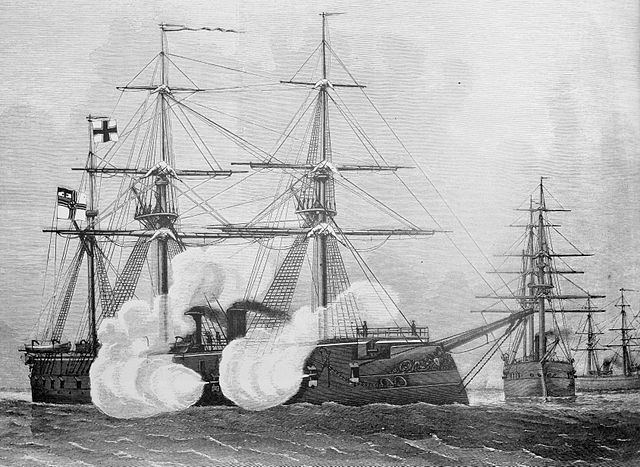
She was with the Ironclad Training Squadron on 19 May 1874 as squadron flagship with Friedrich Carl, corvette Ariadne, gunboat Albatross for Konteradmiral Henk. They trained in May and in the Baltic by June, then a cruise to Britain and Isle of Wight, the Atlantic for maneuvers and back home on 29 July and the Baltic in August, and decommissioned in Wilhelmshaven. Recommissioned on 19 May 1875 for another stint in the Ironclad Training Squadron; KzS Paul Grapow served as the ship’s captain at that time. For the year’s summer training cruise, Kronprinz and König Wilhelm were joined she joined SMS Kaiser and Hansa training in German waters. She lost her flagship status to König Wilhelm. The ironclad squadron of 1868 comprised Kronprinz, Friedrich Carl, Kaiser, Deutschland, departing for their first Mediterranean cruise after the murder of the German consul in Salonika (Ottoman Empire), part of an international demonstration. The sqn. went back home but Kronprinz, and it was dissolved on the 23rd. In September she was still in the Mediterranean and sailed back home on 20 December, Jade Bay on 28 January 1877 but in a severe storm. She lost her jibboom and only entered the Jade on 1 February, docked for repairs at Wilhelmshaven and she missed 1877 training exercises.
She missed the 1878 training cruise as well after the loss of Grosser Kurfürst in an accidental collision with Kaiser. She was reactivated in May but Friedrich Carl was flagship and she sailed out with Preussen and Friedrich der Grosse to Norwa. Reserve 1880, recommissioned 1881, replcing Sachsen (unreliable engines) in German waters. In May she towed the barracks ship Elbe to Kiel. She suffered from Engine problems constantly in the 1880s and they broke down in the May 1883 fleet maneuvers, same for two armored frigates leading to cancellation. In 1884 she took part in a large-scale simulated attack on Kiel, Kronprinz playing the “eastern” opponent against the corvettes Luise and Blücher, operating only on steam power.
Kronprinz was modernization from late 1883, new boilers, six Hotchkiss cannons, six torpedo tubes, rigging was to steel military masts with spotting tops. By 1884, the four Sachsen-class ironclads constituted the new training squadron, Kronprinz being relegated to a second quadron with other ironclads, equipped with anti-torpedo nets in 1885, removed in 1897. In 1887 she was in the ceremonies for the Kaiser Wilhelm Canal. On 1 October 1891 she recommissioned for the Training Squadron’s first winter training cruise to Scotland and Norway and she was at the 1892 training with large scale fleet maneuvers. Decom. on 4 October, last time.
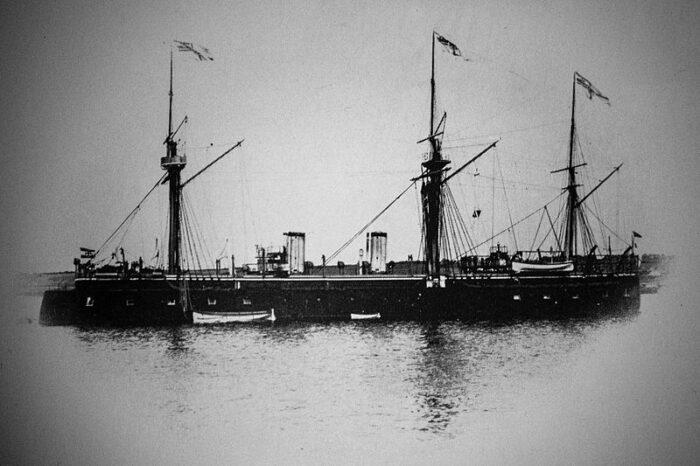
Kaiser Wilhelm II wanted a completed reconstruction and modernization of Kronprinz and Friedrich Carl to sell them to Qing China in 1894 as tensions rose with Japan. This would free the fleet and enabled them to order the parliament to vote two new cruisers. The First Sino-Japanese War prevented this. Wilhelm II suggested buying them on his private funds for a resell, but the shipyard precised the process would be too costly and long for 25 years old vessels and of low value for the Chinese fleet. Japan at the same time wanted to buy ships in Germany so this was dropped. On 22 August 1901, Kronprinz was stricken but sitll reconstructed at the Kaiserliche Werft, Kiel with a modern propulsion system and rwo Dürr and two Thornycroft boilers installed, barque rig was cut down to 1,409 square meters (15,170 sq ft) to serve as a training ship for engine-room personnel in Kiel. She was sold for BU on 3 October 1921.
Read More/Src
Books
Dodson, Aidan (2016). The Kaiser’s Battlefleet: German Capital Ships 1871–1918. Barnsley: Seaforth Publishing.
Gottschall, Terrell D. (2003). By Order of the Kaiser: Otto von Diederichs and the Rise of the Imperial German Navy, 1865–1902.
Gröner, Erich (1990). German Warships: 1815–1945. Vol. I: Major Surface Vessels. NIP
Hildebrand, Hans H.; Röhr, Albert & Steinmetz, Hans-Otto (1993). Die Deutschen Kriegsschiffe: Biographien. Ratingen: Mundus Verlag.
Lyon, Hugh (1979). “Germany”. In Gardiner, Robert; Chesneau, Roger; Kolesnik, Eugene M. (eds.). Conway’s All the World’s Fighting Ships 1860–1905.
Olivier, David H. (2004). German Naval Strategy, 1856–1888: Forerunners to Tirpitz. London: Frank Cass.
Pollock, Arthur W. A. (1869). “Foreign Summary, part 3”. United Service Magazine. Hurst and Blackett Publishers
Sondhaus, Lawrence (2001). Naval warfare, 1815–1914. London: Routledge.
Wilson, Herbert Wrigley (1896). Ironclads in Action: A Sketch of Naval Warfare from 1855 to 1895. London: S. Low, Marston and company.
Links
https://de.wikipedia.org/wiki/Kronprinz_(Schiff,_1867)
http://www.navypedia.org/ships/germany/ger_bb_kronprinz.htm
https://en.wikipedia.org/wiki/SMS_Kronprinz_(1867)
https://commons.wikimedia.org/wiki/Category:SMS_Kronprinz_(ship,_1867)
https://archive.org/details/ironcladsinacti00wilsgoog
https://books.google.fr/books?id=HdgRAAAAYAAJ&pg=PA416&redir_esc=y#v=onepage&q&f=false

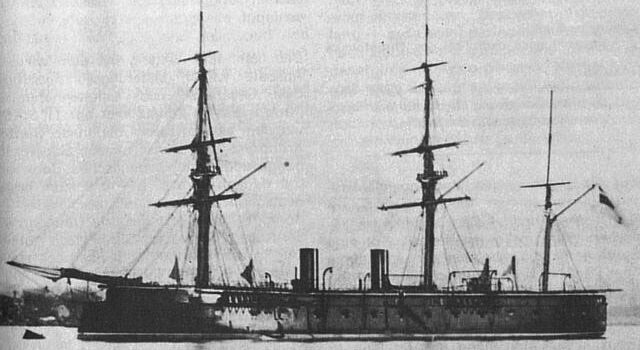
 Latest Facebook Entry -
Latest Facebook Entry -  X(Tweeter) Naval Encyclopedia's deck archive
X(Tweeter) Naval Encyclopedia's deck archive Instagram (@navalencyc)
Instagram (@navalencyc)





 French Navy
French Navy Royal Navy
Royal Navy Russian Navy
Russian Navy Armada Espanola
Armada Espanola Austrian Navy
Austrian Navy K.u.K. Kriegsmarine
K.u.K. Kriegsmarine Dansk Marine
Dansk Marine Nautiko Hellenon
Nautiko Hellenon Koninklije Marine 1870
Koninklije Marine 1870 Marinha do Brasil
Marinha do Brasil Osmanlı Donanması
Osmanlı Donanması Marina Do Peru
Marina Do Peru Marinha do Portugal
Marinha do Portugal Regia Marina 1870
Regia Marina 1870 Nihhon Kaigun 1870
Nihhon Kaigun 1870 Preußische Marine 1870
Preußische Marine 1870 Russkiy Flot 1870
Russkiy Flot 1870 Svenska marinen
Svenska marinen Søværnet
Søværnet Union Navy
Union Navy Confederate Navy
Confederate Navy Armada de Argentina
Armada de Argentina Imperial Chinese Navy
Imperial Chinese Navy Marinha do Portugal
Marinha do Portugal Mexico
Mexico Kaiserliche Marine
Kaiserliche Marine 1898 US Navy
1898 US Navy Sovietskiy Flot
Sovietskiy Flot Royal Canadian Navy
Royal Canadian Navy Royal Australian Navy
Royal Australian Navy RNZN Fleet
RNZN Fleet Chinese Navy 1937
Chinese Navy 1937 Kriegsmarine
Kriegsmarine Chilean Navy
Chilean Navy Danish Navy
Danish Navy Finnish Navy
Finnish Navy Hellenic Navy
Hellenic Navy Polish Navy
Polish Navy Romanian Navy
Romanian Navy Turkish Navy
Turkish Navy Royal Yugoslav Navy
Royal Yugoslav Navy Royal Thai Navy
Royal Thai Navy Minor Navies
Minor Navies Albania
Albania Austria
Austria Belgium
Belgium Columbia
Columbia Costa Rica
Costa Rica Cuba
Cuba Czechoslovakia
Czechoslovakia Dominican Republic
Dominican Republic Haiti
Haiti Hungary
Hungary Honduras
Honduras Estonia
Estonia Iceland
Iceland Eire
Eire Equador
Equador Iran
Iran Iraq
Iraq Latvia
Latvia Liberia
Liberia Lithuania
Lithuania Mandchukuo
Mandchukuo Morocco
Morocco Nicaragua
Nicaragua Persia
Persia San Salvador
San Salvador Sarawak
Sarawak Uruguay
Uruguay Venezuela
Venezuela Zanzibar
Zanzibar Warsaw Pact Navies
Warsaw Pact Navies Bulgaria
Bulgaria Hungary
Hungary

 Bundesmarine
Bundesmarine Dutch Navy
Dutch Navy Hellenic Navy
Hellenic Navy Marina Militare
Marina Militare Yugoslav Navy
Yugoslav Navy Chinese Navy
Chinese Navy Indian Navy
Indian Navy Indonesian Navy
Indonesian Navy JMSDF
JMSDF North Korean Navy
North Korean Navy Pakistani Navy
Pakistani Navy Philippines Navy
Philippines Navy ROKN
ROKN Rep. of Singapore Navy
Rep. of Singapore Navy Taiwanese Navy
Taiwanese Navy IDF Navy
IDF Navy Saudi Navy
Saudi Navy Royal New Zealand Navy
Royal New Zealand Navy Egyptian Navy
Egyptian Navy South African Navy
South African Navy






























 Ukrainian Navy
Ukrainian Navy dbodesign
dbodesign